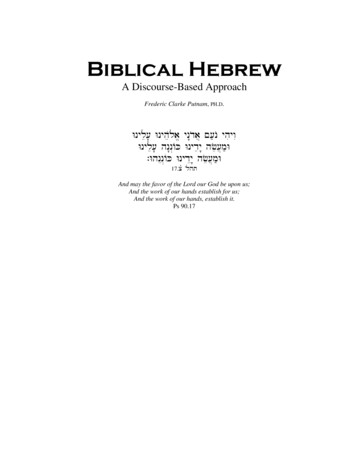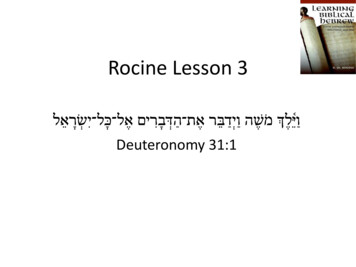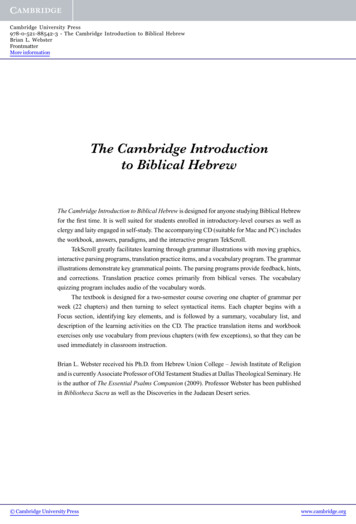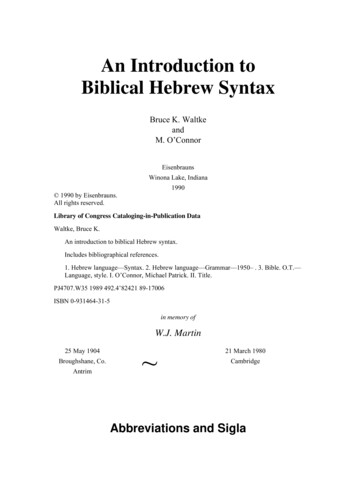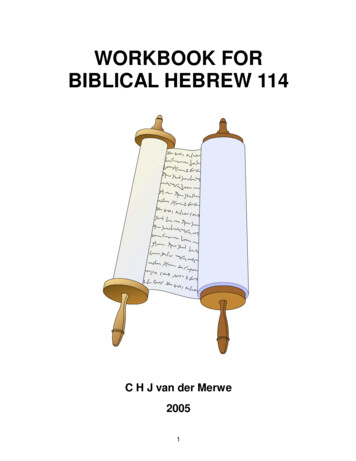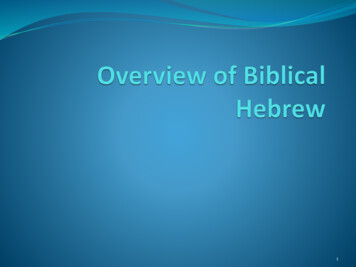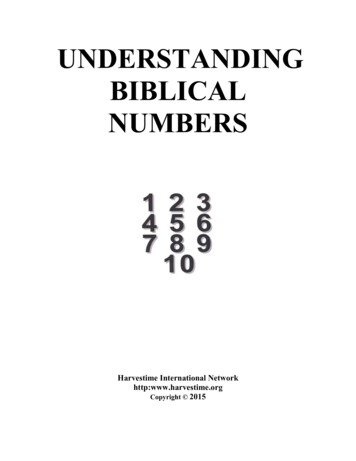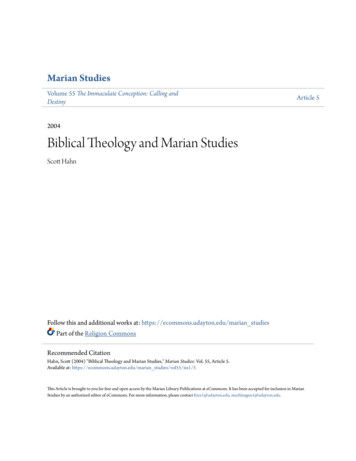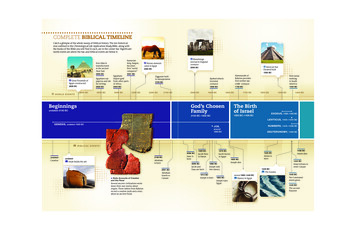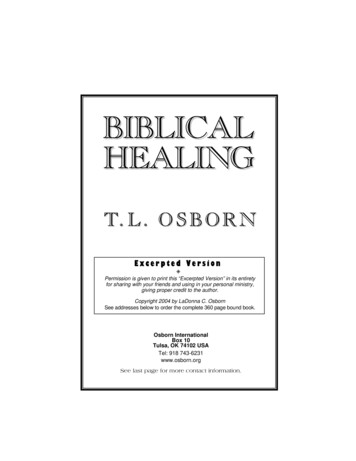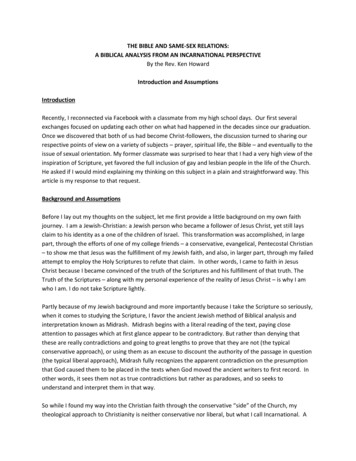
Transcription
THEO5302 Biblical Hebrew II聖經希伯來文(二)Lecturer: Dr. LI Kwan Hung Leo(email: khlileo@cuhk.edu.hk)2018-2019 2nd TermMon 2:30pm-4:15pm CCT T31;Thur 11:30am-12:15pm CCT T31Course DescriptionThis course, a sequel to THEO 3217 Biblical Hebrew I, will continue to follow the textbook, LearnBiblical Hebrew by John H. Dobson (2005), covering Lessons 14-25. It will cover all the binyanim (orstem) of Hebrew as well as understanding concepts of Hebrew syntax, function of prepositions and theprinciples of translating narratives and poetry. In particular, we shall read the Masoretic Text of the bookof Jonah (a narrative with a poem) with the help of the Lexicon and other Bible aids.Course ObjectivesKnowledge OutcomesThe students will be competent in the following abilities:1. recognize every component in the parts of speech learned in THEO 32172. identify the binyanim (or stem) and functions of all verbs3. recall the forms and functions of the prepositions and particles4. identify, recognize at least 500 of the most common Biblical Hebrew words found in the HebrewBible5. search words in the Biblical Hebrew dictionaries and lexicons and explain the entries, inparticular the BDB Lexicon6. parse and translate given phrases/sentences and the book of Jonah7. use the parsing tools from the internet and/or computer software8. read and translate short narrative passages and some poems from the Hebrew Bible9. read and comment on the Hebrew grammar in the book of JonahAttitude OutcomesThe students will1. be confident to read a Biblical Hebrew passage on their own with the necessary tools2. develop the habit of reading Biblical Hebrew passages3. appreciate the basic tasks to do exegesis and interpretationPage 1 of 6
List of TopicsTopics1. ParticiplesContents and Concepts1. The Participle forms and sufformatives.2. The functions of Active and Passive participles.2. The General Uses of 1. The significance of each binyan and how to distinguish them.the binyanim2. The list of uses for each binyan.3. The Qal and Niphal 1. The paradigms for Qal and Niphal.2. The functions of Qal and Niphal.4. The Piel and Pual1. The paradigms for Piel and Pual.2. The functions of Piel and Pual.5. The Hiphil and1. The paradigms for Hiphil and Hophal.Hophal2. The functions of Hiphil and Hophal.6. The Hithpael and1. The paradigms for Hithpael and the other binyanim.the other binyanim2. The functions of Hithpael and the other binyanim.7. Using BDB Lexicon 1. The format of a Biblical Hebrew Dictionary and Lexicon.2. Understanding the division of root words.3. The steps to retrieving the meanings for the word searched.4. Interpreting the information from the dictionary and lexicon.8. Wishes, Oaths and1. The biblical Hebrew expressions for wishes and oaths.Conditions2. The common words and pattern for such expressions.3. The common words and format for conditional statements.9. The Narrative forms 1. Revision of the waPC.with other verb forms2. The different conjugation and expressions before the waPC verbs.3. How to distinguish and translate different occurrences of the waPC in various contexts.10. Sentence andThe different ways biblical Hebrew begins passages – narratives and non-narratives and howClause Beginningsto translate them.11. The Perfective and 1. Revision of the SC and PC.Imperfective Verbs2. Consideration of more complex contexts and how to translate appropriately.12. Sentence andFunctions of these sequences:Clause Sequences1. SC wSC forms.2. SC waPC.3. PC wPC.4. Clauses that begin with some particles.5. PC wSC.6. Imperatives imperatives.7. Imperative wPC.8. Participle waPC.9. Participle wSC.10. Infinitive waPC.11. Infinitive wSC.12. 5 conjunctions.13. Translating1. Characteristics of biblical Hebrew poetry: balance and parallelism.Hebrew Poetry2. Expressions of balance and parallelisms: chiasmus and alphabetic.3. Language of biblical Hebrew poetry.4. Issues in translation.14. Prepositions1. Summarize the types and most common occurrences of some prepositions.2. Determining the possible best meaning for a preposition.15. Idioms and AreasLearn some common idiomatic expressions in biblical Hebrew and their meanings, or areas ofof Meaningsmeanings according to the context and interpreting their functions.16. Learn Bible1. Introduce various aids from the internet and/or computer software.Aids from Internet and 2. How to access the parsing functions and interpret meaningfully from these aids.computer softwarePage 2 of 6
Course Structure and RequirementsStructure/ Input and Output The class meets every Monday for 2 class periods of lecture and Thursdayfor another class period. A new topic will be introduced via lecture or through some class activities, andthe learning will be reinforced through fulfilling class assignments and homework, followed byevaluation. For every hour of class period, students are expected to put in about 1.5 to 2 hours.Learning ActivitiesWe will do a lot of drilling exercises through different forms: in songs, oral recitation, oral exercises,dialogue and writing exercises. There will be reinforcements through one to one and small groupinteractions throughout the course.Requirements and assessment schemeTask Nature and Weightage1. Compulsory Attendance and ActiveParticipation (10%)A penalization of 0.5% of this grade foreach missed period of tutorial/lecture. Ifstudents have valid reasons to misslectures and tutorial sessions for 10class periods, students are expected towithdraw from the course asap.Otherwise, a full penalization of 15% ofthe final grade applies. Penalization ofthis grade applies regardless of validor invalid reasons.Purpose and RationaleLanguage courses requireconstant drilling, and dueto the fact that BiblicalHebrew is a deadlanguage, absence fromany period will result indifficulties to catch up foreach class period. .Learning Outcomes1. Students can follow theprogress of each topic smoothly.2. Students build upon each newconcept of the language based onthe previous one.3. Students can reinforce thelearning through active use of thelanguage.1. Students will follow thesmooth progress ofbuilding upon each topic as 4. Student learns to reinforce theirthe language is taught.own understanding with colearners and the instructor.Students must participate pro-actively in 2. Students get immediateclass as required: Pro-active refers toreinforcements for eachlearning activities where students arenew word or conceptexpected to verbalize pronunciation oflearned.words learned, sing, recite verbally – allin audible volume to their partners, orinstructor or to keep pace with the wholeclass. There will be penalization of thefull 10% from this course if students donot engage pro-actively. Students will bepre-warned of this possibility as theclass progresses.2. 6 Quizzes (30%)Regular Quizzes will be held duringclass time. Please check the CourseSchedule as to when these quizzes willPage 3 of 6The quizzes are toreinforce the accumulationof the foundationalbinyanim paradigms.Regular parsing in the1. Students’ memorization of thebinyanim paradigms will aid thelearning progress of the formsand uses of the verbsfoundational to the language.
be held. What will be quizzed depending quizzes are to keep up andon students’ pacing but the followingreinforce the vocabulariestopic will be covered:and paradigms learnedearlier and also new The General Uses of the binyanimvocabularies.(D p. 159); Paradigm for the binyanimincluding Qal, Niphal, Piel, Pual,Hiphil, Hophal and Hithpael; Parsing of various Hebrew verbs; Using BDB Lexicon; Translating of texts selected fromthe Hebrew Bible.The topic that will be covered for eachquizzes will be announced over theBlackboard a week before the quiz.3. Written Assignments (30%)During class lectures, the instructor willassign written assignments wherestudents are required to write on theboard, or on their own notebooks, orpapers to be submitted. Students areexpected to follow these instructions andattempt to complete them.Students also need to comment on theHebrew grammar of the selected text.3. Final Quiz (30%)This quiz comprises of selectedpassages learned throughout thecourse. Besides parsing, there will bequestions covering topics learned fromTHEO5301-02.2. Students will reinforce earliergrammar and vocabularieslearned earlier through theparsing component in thequizzes.3. Students will be able to readand understand more complexsentences in the Hebrew Bible.4. Students will be able to parsephrases as they read and will beable to process the meanings ofthe words automatically.5. Students learn how to use theBiblical Hebrew Lexicons andDictionaries. Students learn thetechnical format and how toretrieve the relevant meanings forthe word searched.To grasp Biblical Hebrewfully, the written form isquintessential. It aidsrecognition and reinforcesmemory. Writing out theassignments retains thelearning in concrete form.1. Students reinforce theconcepts by active application ofthe language through thesewritten assignments.2. Students get the opportunity forimmediate reinforcements inclass through these assignments.3. Students learn how tocomment on grammaticalfeatures of the Hebrew text.This final quiz wraps up the Same as Task #2.end of the basics of thecourse.Course TextbookJohn H. Dobson, Learn Biblical Hebrew (2nd ed.; with Audio CD-Rom; Grand Rapids: Baker Academic, 2005).Francis Brown, S.R. Driver, and Charles A. Briggs (ed.), A Hebrew and English Lexicon of the Old Testament(Oxford: Clarendon, 1907). [check the latest reprint] (use can also access through the website: bible.cc)Page 4 of 6
Course Components:The course consists of lectures, oral drills, written assignments and a lot of memorization, self and grouprevisions. The time allocation (on average per week) of the learning activities is as follows:LectureClass interactionExcursion/Web-based repotReading andresearchWrittenassignmentsIn classOut ofClassIn classOut ofClassIn classOut ofClassIn classOut ofClassIn classOut ofClass1.2 hrsNA1 hrNANANANA1.5 hrs0.52 hrsMMMMMM: Mandatory activity in the course O: Optional activityCourse ScheduleWeek 17 Jan (Mon)Introduction: Revision of Basic Grammar and Biblical Hebrew;Infinitives and Participles; Jonah 1:1-3 and 3:1-4;10 Jan (Thur)Introduction to binyanim: The General Uses of the binyanim.(Introduction to lesson 14-17)Week 214 Jan (Mon)The Qal and Niphal (Lesson 14)17 Jan (Thur)Read Psalm 23Week 321 Jan (Mon)Quiz 1; Lesson 19: Narrative Form24 Jan (Thur)Learning to Use the BDB;Dictionary Exercise (p.160-162): Jonah 1:4-16/3:5-10Week 428 Jan (Mon)Piel and Pual (Lesson 15); Assignment 131 Jan (Thur)Introduction to Internet/computer aids for the analysis of Biblical HebrewWeek 54 Feb (Mon)Lunar New Year Holiday7 Feb (Thur)Lunar New Year HolidayWeek 611 Feb (Mon)Quiz 2 (Knowledge up to Week 4);Lesson 20: Sentence and Clause Beginnings;14 Feb (Thur)Dictionary Exercise (p.171): Jonah chapter 4; Hand in Assignment 1Week 718 Feb (Mon)Hiphil and Hophal (Lesson 16)21 Feb (Thur)Reading and Parsing Jonah 1:4-16;Week 825 Feb (Mon)Quiz 3 (Knowledge up to Week 7);Lesson 21: Perfective and Imperfective verbs28 Feb (Thur)Page 5 of 6Hithpael and the other binyanim (Lesson 17); Assignment 2
Week 94 Mar (Mon)Quiz 4 (Knowledge up to Week 8);Lesson 22: Sentence and Clause Sequences7 Mar (Thur)Reading and Parsing Jonah 3:5-10Week 1011 Mar (Mon)Quiz 5 (Knowledge up to Week 9);Lesson 18: Wishes, Oaths, and Conditions14 Mar (Thur)Reading and Parsing Jonah 4:1-11; Hand in Assignment 2Week 11;18 Mar (Mon)Quiz 6 (Knowledge up to Week 10);Lesson 23: Translate Hebrew Poetry; Jonah 2A21 Mar (Thur)Reading and Parsing Jonah 2B; (Assignment 3)Week 1225 Mar (Mon)Lesson 24: Prepositions/ Lesson 25: Idioms and Areas of Meaning28 Mar (Thur)Reading and Parsing exercise;Week 131 Apr (Mon)Reading Week4 Apr (Thur)Reading WeekWeek 148 Apr (Mon)Revision11 Arp (Thur)Reading and Parsing exerciseWeek 1516? Apr (Tue)Final Test (the date need to be confirm in the class)18? Apr (Thur)Go through answer; Hand in Assignment 3 (the date need to be confirm in the class)Feedback for EvaluationTwo course evaluations will be conducted. The first will be done midway through the course which istailored to facilitate better progress through the course. The second will be conducted by the universitywide exercise.Recommended Learning Resources:Kahn, Lily. The Routledge Introductory Course in Biblical Hebrew. NY: Routledge, 2014.Page, Kelley H. Biblical Hebrew: An Introduction Grammar. Grand Rapids, Michigan: W.B. Eerdmans, 1992.Pratico, Gary D. and Miles V. van Pelt. Basics of Biblical Hebrew Grammar. Grand Rapids, Michigan: Zondervan,2001.Seow, Choon-Leong. A Grammar for Biblical Hebrew. Rev. ed.; Nashville: Abingdon, 1995.Webster, Brian. The Cambridge Introduction to Biblical Hebrew. Cambridge/NY: Cambridge University, 2009.Yeung, Philip. Functional Hebrew: Lecture Notes with Exercises. Hong Kong: China Graduate School ofTheology, 1986.Page 6 of 6
4. identify, recognize at least 500 of the most common Biblical Hebrew words found in the Hebrew Bible 5. search words in the Biblical Hebrew dictionaries and lexicons and explain the entries, in particular the BDB Lexicon 6. parse and translate given phrases/sentences and the book of Jonah 7. use the parsing tools from the internet and/or computer software 8. read and translate short narrative passages and

